It would be just like me to tease you with a clever, ironic headline like this introducing a long, detailed analysis of the British mortality data. But in this case, I’m being serious. This article is about why I think the data are unreliable and unworthy of our credence.
In August, the British Office of National Statistics (ONS) released data on all-cause mortality broken down by age and vaccination status. The ONS data covers months from April, 2021 through May, 2023.
This is exactly what we need to determine if the COVID vaccines have saved lives. Data by “cause of death” are tainted because hospitals have been incentivized to treat deaths “with COVID” differently from other deaths. But total death counts are harder to corrupt. I wish that more countries would release such data. (Are you listening, CDC?)
I’ve written about dangers of the COVID shots, including one analysis estimating deaths in the hundreds of thousands for the US alone. I should be eager to vindicate my prediction with new data, and the aggregated British data appear damning.
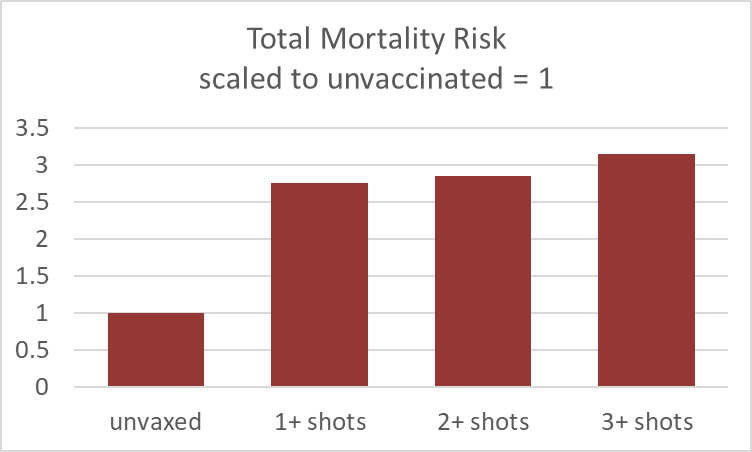
On its face, the straightforward, aggregate calculation says that vaccinated people are three times more likely to die than unvaccinated.
The British data is broken down into seven age categories. (Children are not included. The lowest age category is 18-39, and thereafter the age categories are by decade.) Let’s zoom in on the youngest age group:
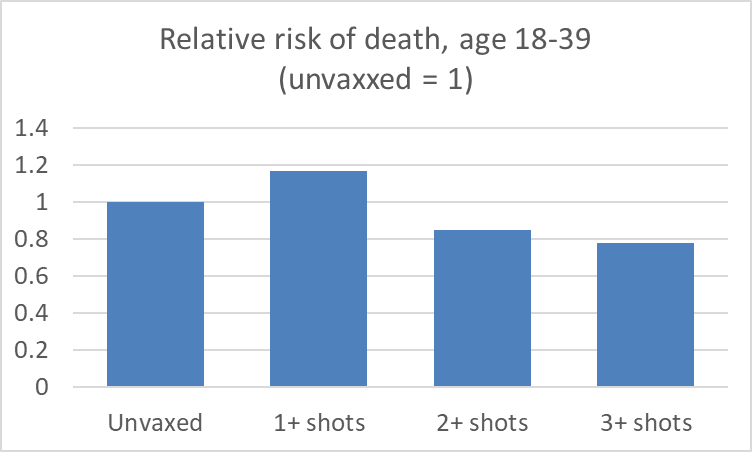
A small number of subjects had bad reactions to the first shot, and discontinued from there. These people have elevated risk from the vaccine, but among those who went on to get the full sequence + boosters, the shots appear to be protective.
Other age groups show the same pattern. For example,
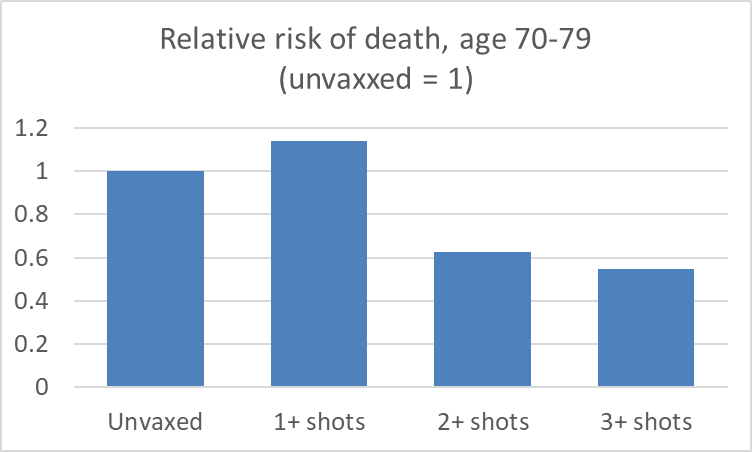
For every age group, multiple COVID shots appear to be protective against death from any cause.
A statistics lesson
Of course, it’s mathematically impossible that within every age group, the vaccinated are at lower risk of death but when you aggregate all the age groups together, it turns out that vaccinated people are at a higher risk of death.
That’s what I thought. I spent a whole evening checking and rechecking the calculation.
But I might have remembered Simpson’s Paradox.
The data are correct. The graphs are correct. The key to understanding the situation is that the lion’s share of the deaths (the numerator) are in the oldest age groups, but most of the head count (the denominator) is in the younger age groups.
Crucially, the vaccination rate among the young is much lower than among the old.
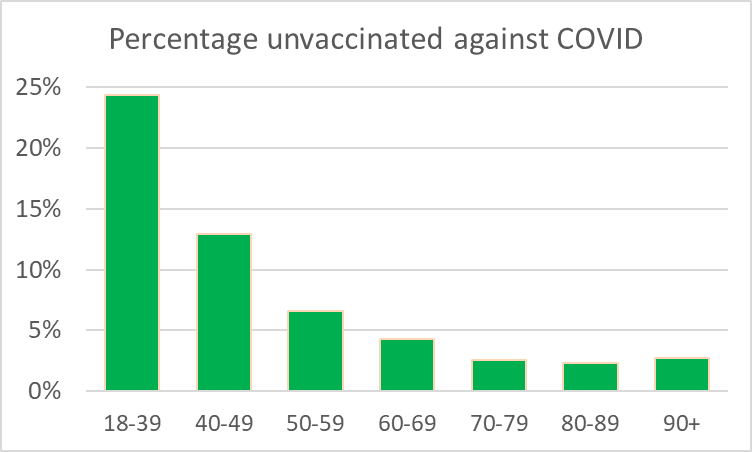
So what we are seeing in the aggregate chart is that the oldest people are more likely to be vaccinated, and they are also more likely to die. But that doesn’t mean that vaccination is causing the deaths.
So, does this vindicate the vaccines?
I have written and others have written that side effects from the COVID vaccines, including risk of death, are so much higher than vaccines of the past that it’s hard to see them on the same scale.

Furthermore, there is insurance data showing that death rates are up as much as 40% in working people, and anecdotes tell of people having sudden heart attacks and (widely “debunked”) turbo cancers.
How can this be reconciled with the idea that, in each age group, multiple COVID vaccinations are associated with lower rates of death from all causes?
In the 18-39 age group, almost no one is dying from COVID. The most significant causes of death are accidents, suicide, and overdoses. It is not reasonable to think that three COVID shots have the effect of lowering these risks by 20%.
The most plausible explanation is a strong “healthy user” effect. People who are unvaccinated are, on average, poorer and less educated than the rest of the population, and it is well-accepted that death rates are closely correlated with social class, especially at the lower end. More speculative is that the data has been tampered with, deliberately doctored to hide the vaccines’ dangers. See below, “Fraudulent manipulation…”
For these reasons, I think there is not much to be learned from the new British data.
A pattern too stark to ignore
There is one result embedded in the data that is highly significant (p<0.00002) and implies a role in the vaccines for excess mortality in 2021. During the months March – December, the all-cause death rate in the UK rose by 30%, and the rise was tightly correlated with the cumulative number of vaccinations (R=0.96).
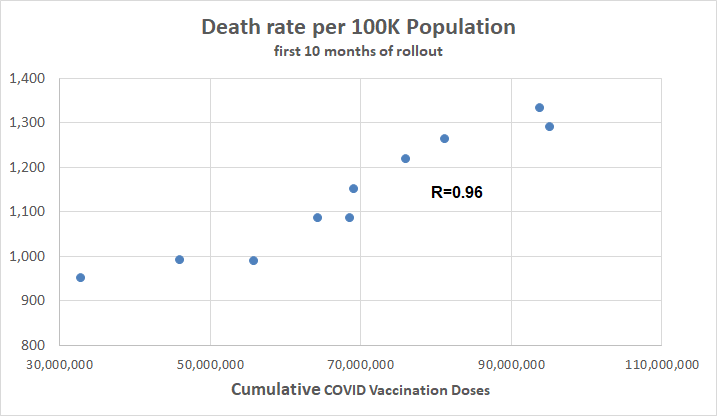
This rise did not continue into 2022, but the overall death rate remained elevated. This pattern, again, cannot be explained as simply as a huge death toll from the vaccine. Thirty percent is enormous, and cannot be hidden by any government’s manipulation of the statistics.
I know… Ed Dowd has famously documented a 40% rise in insurance claims against corporate group life policies; but it was only possible to hide that 40% bump because the base rate among these young people employed by large corporations was so low that 40% of that was too small to show up in a graph of whole-population mortality, which is always dominated by the oldest segments.
Since the British mortality increase is in the population as a whole, it must be concentrated in the older population. Part of the 30% rise was seasonal. Death rates increase 25% winter over summer. But part of the increase is likely due to a lingering effect of the vaccines on mortality and morbidity in the oldest group. Evidence for this is in the continuation of the graph into 2022 and 2023. Death rates are more variable, but we see that they reach new highs in the winter of 2023 and never return to baseline.
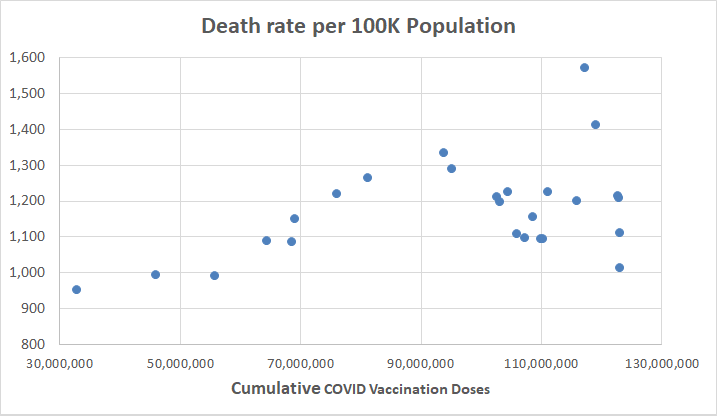
Fraudulent manipulation of the ONS data?
Last winter, Madhava Setty publicized research by Norman Fenton suggesting that ONS had tampered with their COVID data. The strongest evidence was for the early months, Jan-Mar of 2021, which are unaccountably absent from the latest edition of the ONS data. The current edition begins with April, 2021. The following graphs are derived from the ONS data release in July, 2022.
The charge that is easiest to verify is that deaths from the vaccine rollout have been shifted into the “unvaccinated” column. We can see this in the form of a spike in deaths of the unvaccinated just as the vaccines were being rolled out. This is most prominent in the death rate for the oldest groups.
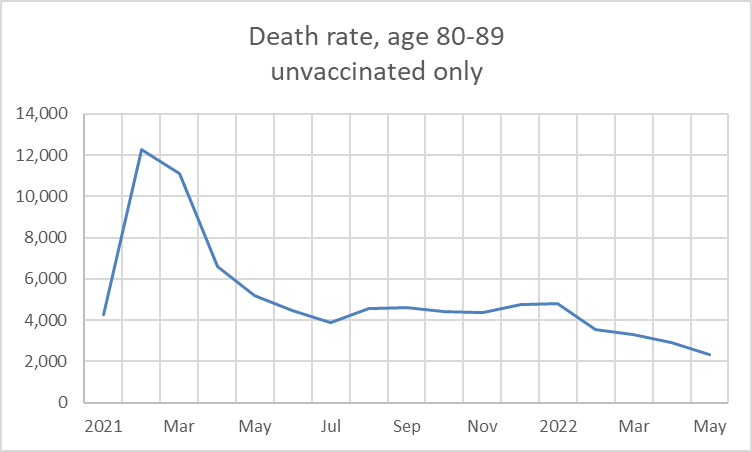
This spike is hard to miss — three times as many deaths as expected in the small “unvaccinated” group in those first months when the much larger vaccinated group of elders was being given early priority for the vaccine. Nursing homes were first to be vaccinated.
In the spring, the vaccine was distributed to middle-aged citizens, and — remarkably — we see a similar bump in deaths of “unvaccinated” people in that age group. The bump started later and is more spread out, corresponding to the fact that middle-aged people signed up for the vaccine more gradually.
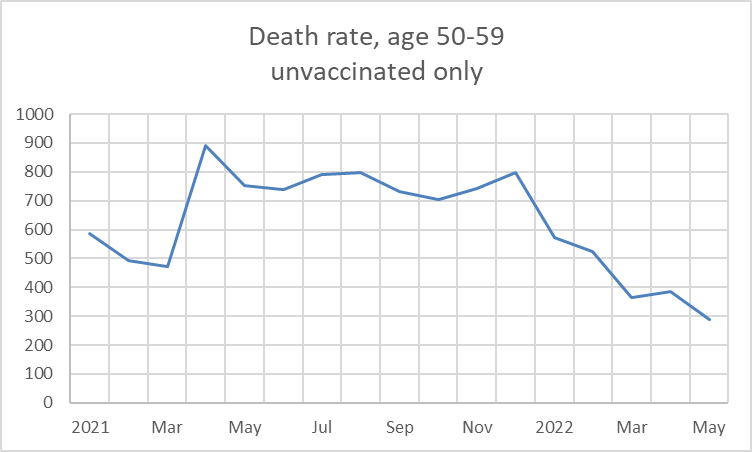
Starting in the summer, the vaccine was recommended for younger people, and we see a bump for mortality in “unvaccinated” adults under 40 begin in June.
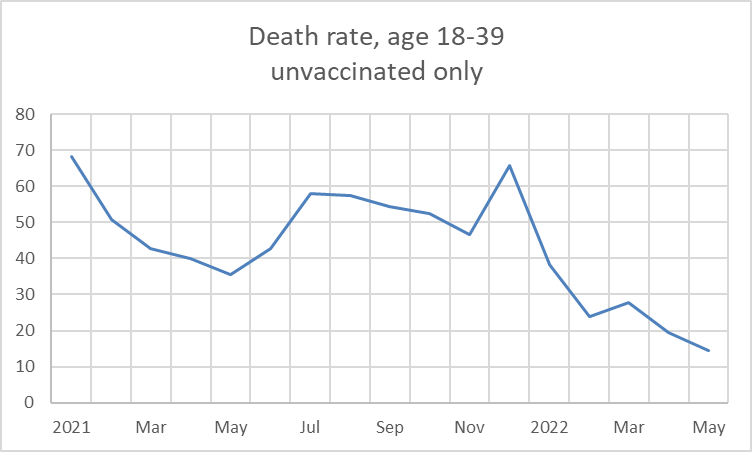
The Jan-Mar data for 2021 has been censored in the new ONS release, and with it the evidence for the obvious spike in the older age groups. But what of the humps for younger age groups? Are they visible in the new data?
To answer this, I’ve plotted data from 2022 and 2023 on the same graph for each age range, so we can see where they match and where they don’t. At older ages, the data match nicely.
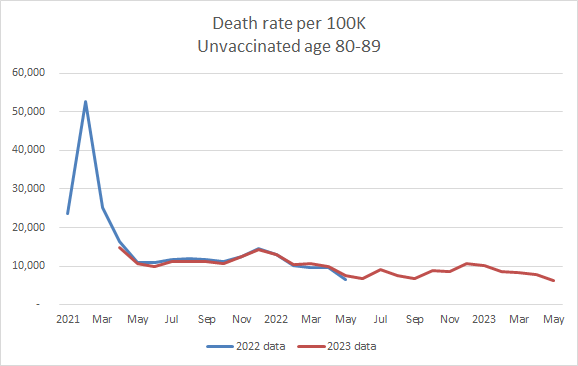
But for younger ages, the data have been revised upward, making the humps more prominent. I interpret this to mean that more post-vaccine deaths have been moved into the “unvaccinated” group.

For the youngest ages, it looks as though the data were adjusted more, proportionally, but the scale is much smaller because the death counts are very low for the young.
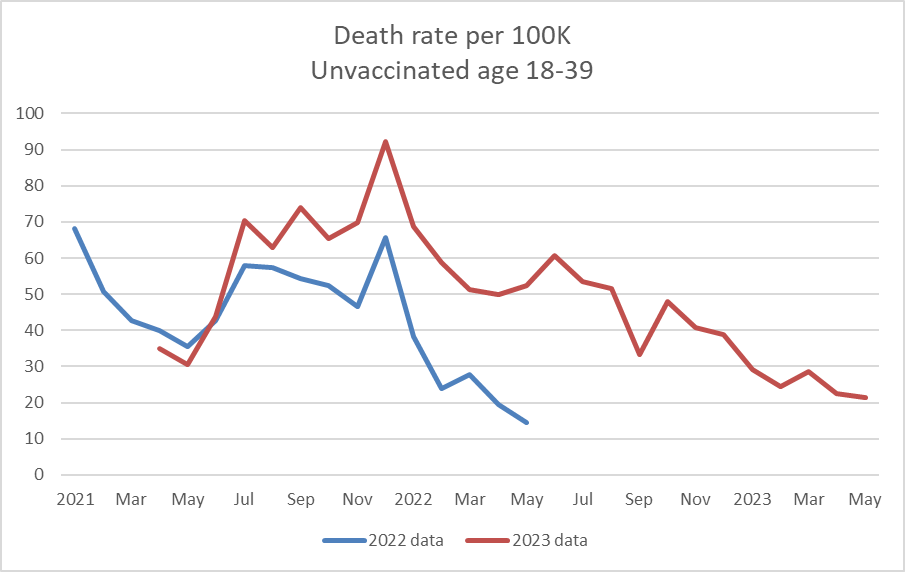
The bottom line
I’ll end where I began this entry. I’m not going to analyze the British ONS data because I don’t think the numbers are reliable.
Discover more from Josh Mitteldorf
Subscribe to get the latest posts sent to your email.

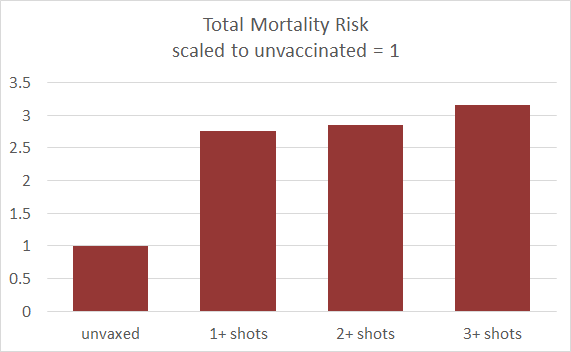
Add COVID-19 cases to this last set of graphs – see if these can explain the increases in death rate. And add mortality from 2019.
Are people in the UK in 2023 still getting vaccinated a lot? Younger ones too? At roughly the same time as in 2022? If I understand you correctly, this would have to be true if the 2023 curves are due to doctoring the data as you suggest.
There’s a substantial seasonal component to mortality, about 25% higher in winter than summer. And the years 2020-23 have been extraordinary because of unprecedented public health measures. All these factors complicate a comparison between years.
In Chile, the average mortality per year for the 5 years before 2020 was about 96K. Mortality was highest in 2021 (135K) but remains about 20% above average. This year mortality is 83K for the first 9 months so expected to be 115-120K for the whole year. Chile has a very high COVID vaccination rate.
You won’t catch me ever taking those shots. I had a pretty strong case of Covid in 2020 that wasn’t clearing after about 8 days and I had someone bring me the “horse paste” ivermectin from the feed store. My fever broke within 3 hours and it cleared fully over the next 2 days.
You can make a case that the suppression of ivermectin was the greatest mass murder in history, outside of wartime. About 10 million people died who would not have died had they had ivermectin early.
Definitely agree with this.
How is it even possible to separate the vax’ed from the un-vax’ed ? Most people got a synthetic mRNA virus unable to replicate itself, others got a “natural” vaccine from a COVID infection. Add to that the numerous mutations that occured over 3 years.
Josh, Some of the explanation that you seek is in the definition of “vaccinated” and “unvaccinated”. I’ve stopped following the UK data, but followed it quite closely in the first two years of the pandemic. Because the body takes some number of weeks after vaccination to build up antibodies, persons who received the vaccine, but either died or contracted covid before (if memory serves correctly) six weeks were counted as unvaccinated.
This will account for some of the effect you noticed, but not all…
The fraud you describe was used in the Pfizer trial to come up with their “effectiveness” percentage. But in the ONS table that I reference here, there is a separate category for “first 21 days” after each vaccination. Thus, I surmise that some of the deaths in this category were moved into the “unvaccinated” column with no justification whatever.
I agree it is highly suspicious that there are spikes in the mortality data corresponding to the roll out of vaccinations for that age category, and that this is occurring in the unvaccinated. Definitely requires some explanation!
I did get vaccinated, mainly due to having to get it to be able to travel, and it was the third jab – the booster from pfizer, rather than the Astrazeneca ones – that made me ill. I took a load of NAC after a few days and that sorted me out but up to that point I was fairly ill. I know several other people who had similar reactions, but it is far from universal. It tends to be among athletes. Several people I swim with were knocked out by the booster jab for a protracted period. The vaccine itself was useless, as although I’d been highly resistant to getting Covid up to the point of vaccination, despite multiple and prolonged exposures, I later got it. But it was very mild (not as bad as the jab!), whether I can attribute that to the vaccinate or not is arguable.
I personally think the prolonged raised mortality data is due to the lock downs rather than vaccines. Even now in 2023 it is noticeable how many more nasty bugs my kids bring home from school. The worse was a tonsilitis illness that in several people I know has led to further bacterial illnesses.
people don’t die of tonsilitis and we have antibiotics to treat bacterial infections